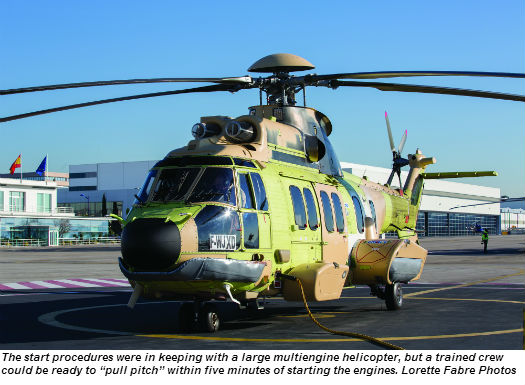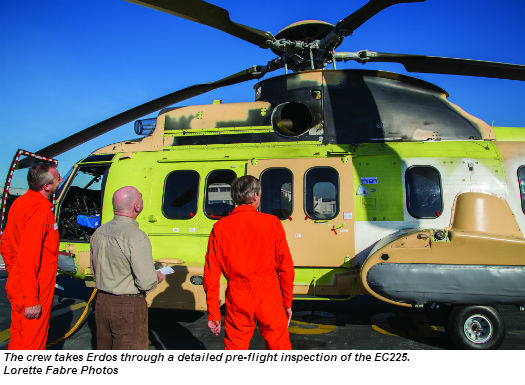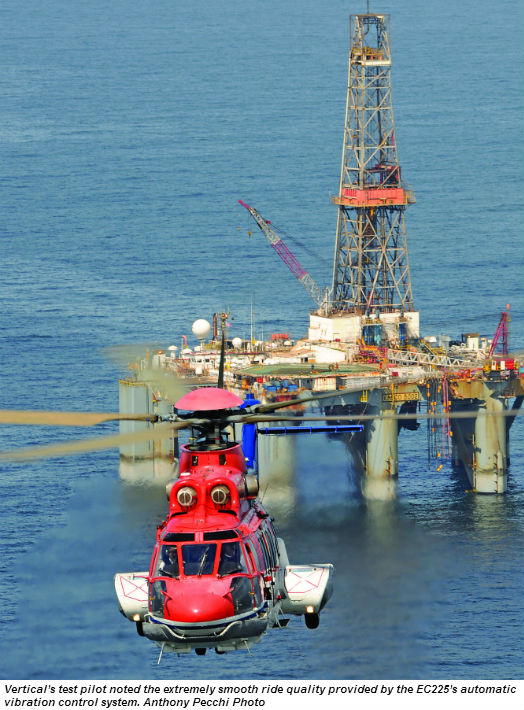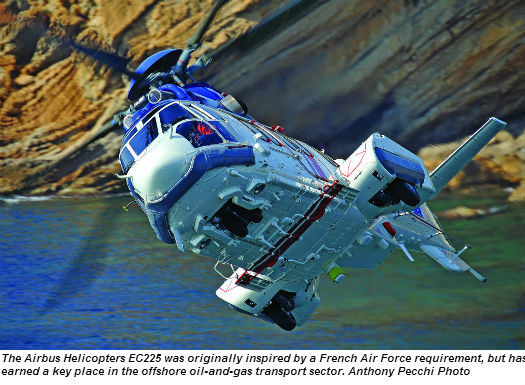There could be no mistaking the purpose of my visit to the Airbus Helicopters (formerly Eurocopter) Test Center in Marignane, France. The EC225 has been in the headlines for much of the past 18 months, due to the extensive investigation, redesign and testing of the section of its gearbox that caused two high profile ditchings in the North Sea in 2012. With 93 percent of the worldwide EC225/725 fleet now back in service, the manufacturer was keen to showcase its capabilities. In the course of a comprehensive evaluation flight, I saw firsthand how the EC225 has earned its key place in the offshore oil-andgas transport sector.

I was privileged to fly with Airbus Helicopters experimental test pilot Hervé Jammayrac and flight test engineer Christophe Skorlic. We settled into the cockpit to review the systems, Jammayrac explaining that the EC225 is a development of the AS332 Super Puma, which was a late-1970s design. The original Super Puma enjoyed several upgrades, and the EC225 is the latest development of the Super Puma family; but as the new type designator denotes, it is more than just an incremental upgrade. The EC225 incorporates a new five-blade Spheriflex rotor, upgraded Turbomeca Makila 2A1 engines, and digital avionics. Although originally inspired by a French Air Force requirement, with an Airbus Helicopters-designed fouraxis automatic flight control system (AFCS) and optional equipment for flight into known icing, it is no wonder that North Sea offshore operators have embraced it.
Our helicopter was configured for delivery to an offshore operator, but was being used by the Airbus Helicopters Test Center for avionics development. It featured standard traffic collision avoidance system (TCAS II) and enhanced ground proximity warning system (EGPWS), plus optional external fuel tanks and dual Canadian Marconi Corporation (CMC) flight management systems (FMS) for offshore operations. Jammayrac claimed that with a typical 6.4 tonne equipped empty operating weight and an 11 tonne maximum gross weight, the EC225 is generally capable of operations with full passengers and full fuel. For our flight, the helicopter had an empty weight of 13,940 pounds (6,323 kilograms). Payload and crew added 1,730 lb (785 kg), and 5,775 lb (2,620 kg) of fuel was onboard, resulting in a gross takeoff weight of 21,445 lb (9,728 kg). The center of gravity was mid-forward.

Jammayrac talked me through the pre-start checks with the ease of someone who was eager to demonstrate how simple it all was. I would have needed a checklist. It is a complex vehicle, but I was favorably impressed with the cockpit layout.
Powerplant and systems data are depicted on two central 4” by 5” liquid crystal displays (LCDs) called the vehicle monitoring system (VMS). The glass cockpit features two bright 6” by 8” multifunction displays for each pilot. Systems integration was not quite state-of-the-art, in that the FMS was capable of only limited performance calculations, and the VMS included neither system synoptic pages nor electronic checklists. A reconfiguration control panel allows selection of alternate attitude or air data sensors, although no facility exists for automatic reversion or composite display selection. The start procedures were in keeping with a complex multi-engine helicopter; however a trained crew could be ready to “pull pitch” within five minutes of engaging the starters.
Lifting the EC225 into the hover was effortless. The AFCS’s attitude and heading hold modes left me with almost nothing to do. At our operating weight we required 75 percent power to hover in ground effect (IGE), which was reassuringly below the 30 second one engine inoperative (OEI) power limit. We hover taxied to the helipad just behind an NH-90, and in what I presumed to be at least moderate rotor wash turbulence, the AFCS attitude retention system did a marvelous job. Hovering remained precise and easy. I performed a few exploratory pedal turns, finding a surprising amount of directional control power for such a big machine. The pedals were light, without any evident centering force. Heading hold mode engaged, I was told, whenever the yaw rate dropped below eight degrees per second and the pilot released the pedal force microswitch. Elegant.

Going Offshore
Outbound from the Marseille airport, I conducted a cruise performance check at 1,500 feet. With the AFCS engaged in heading, altitude and airspeed modes, I selected maximum continuous power (82.7 percent engine torque). The result, at our admittedly light weight, was 146 knots indicated airspeed (KIAS), which at 46 F (8 C) air temperature worked out to also be 146 knots true airspeed. The engines were burning 1,457 lb/hour (661 kg/hour) total fuel flow. The FADECs provided nearly perfect engine matching. I took a moment to note the ride quality, which I can only describe as fabulous. I noted as much to Jammayrac, and he cheerfully emphasized the point by turning the automatic vibration control system off, which resulted in a much rumblier ride. I asked him to turn it back on. Ah, better.

The main engine power indication was a vertical tape on the left side of the primary flight display, called a first limit indicator (FLI). This innovative display depicted the collective pitch in proportion to the available power margin, whether in all engine operative (AEO) or one engine inoperative (OEI) situations. Its utility became apparent during a simulated engine failure. Cruising with the autopilot engaged in heading, altitude and airspeed hold modes at 130 KIAS at 2,500 feet, a small blue line on the FLI clearly indicated that our current power setting was just above the OEI power available. Jammayrac selected the OEI training switch to simulate failure of the left engine. The response was a momentary mild yaw and a prompt collective reduction by the AFCS to respect the 30 second OEI HIGH power limit. As the end of the OEI HIGH power limit approached, I manually selected OEI LOW power limit, followed by continuous power limit. In each case, the AFCS selected the appropriate power setting as we continued on course. The combination of smooth FADEC engine control, compelling displays and generous power margins made the engine failure a non-event.
To better see the EC225 in its element, I performed a coupled approach to a shipping buoy that was, in my vivid imagination, impersonating a North Sea oil rig. As we passed over top, I designated the target using the AFCS’s F/TDN button, denoting a “fix – transition down.” The weather radar picture was overlaid upon the GPS track to show our closure to target. The avionics responded by immediately depicting a 180-degree procedure turn into the prevailing wind on the navigation display, which it followed in a smooth transition to a hover, terminating in groundspeed and height hold mode at 120 feet, 0.1 nm from the buoy. From there it was a simple process to use the cyclicand collective-mounted switches to beep the hover position wherever desired. With its simple interface and smooth predictable performance, I found that the EC225’s AFCS among its most impressive features.

Returning to Marseille, Jammayrac had another demonstration in store. An NH90 was cruising about a mile ahead of us. With a few words on the radio, he arranged for the NH90 to perform a dogleg maneuver such that our flight paths would intersect. As we cruised along with the autopilot engaged, Jammayrac simply pointed to the NH90 and indicated that I should watch. The TCAS began to squawk a traffic advisory, followed by a resolution advisory, which necessitated evasive maneuvering. That’s just what the autopilot did, in the form of a smooth descent to pass several hundred feet below the simulated intruder. When clear of traffic, the autopilot climbed and resumed its original heading, altitude and airspeed — an impressive demonstration indeed! Airbus Helicopters claims that the EC225 is currently the only helicopter certified with this capability.
It is understandable that much of what has been said and written about the EC225 recently has featured the word “gearbox.” The combination of mechanical and electrical deficiencies that resulted in two nearly identical EC225 accidents is lamentable indeed. There can be no doubt that Airbus Helicopters is working hard to put that episode behind them. For my part, my flight in the EC225 convincingly demonstrated that it was a helicopter with impressive performance and capability.





